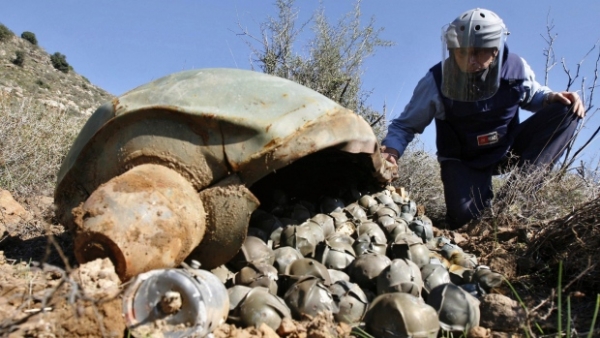5 November 2018
This article presents the report of the International Committee of the Red Cross (ICRC), produced in August 2018, which reflects on the first ten years of the “Convention of Cluster Munitions”.
The Convention was adopted in 2008 to address the issue of death, injury and suffering caused by cluster munitions. In 2015, the Dubrovnik Action Plan followed to supplement the Convention.
To date, these treaties have achieved several notable objectives: 103 States are parties to the Convention and a further 17 are signatories, 18 States have stopped manufacture, and approximately 1.5 million weapons and over 175 million sub-munitions were destroyed. There have been no reports of alleged use of cluster munitions by State Parties, nor of new productions or export. Moreover, the Convention requires State Parties to provide for stockpile destruction within eight years of signature (except for those States who were granted extension until 2024) and clearance of cluster munition remnants within ten years. Stockpile destruction has achieved a success rate of 98%, and over 400 square kilometres of contaminated land have been cleared.
Furthermore, the treaty calls for State Parties to provide assistance in the form of medical care, rehabilitation and psychological support, and socio-economic inclusion in areas under their jurisdiction. This assistance must not be discriminatory, and take consideration of age and gender requirement. At present, most States have implemented casualty data-collection and needs assessments, and granted national disability or assistance action plans. The treaty provides that assistance can be provided by States with more resources.
The Plan aims to strengthen the power of the Convention, and to further encourage State Parties to promote its universalization. This aim is to be achieved through enhanced cooperation, promoting model legislation, supporting the ratification process of new signatories, and advocating subscription to non-party States. The Plan also commits State Parties to assist partners in strengthening national capacity, improving the quality and quantity of victim assistance, and increasing the victim’s role in policy- and decision-making, through enhanced cooperation bilaterally or through regional or international organisations. To this end, States shall designate within their governments focal points for assistance, in the form of money, equipment, expertise, experience and human resources.
However, the Convention still faces many challenges: 77 States are non-parties, 16 of which are capable of, or currently are, carrying out production of cluster munitions. Four States: Lao People’s Democratic Republic, Vietnam, Cambodia and Iraq, are still heavily contaminated by cluster munition remnants. Since 2010, nine States have recorded use of cluster munitions within their borders. The use of cluster munitions had a disproportionate impact of civilians: 90% of casualties are civilian, 40% of which are children. Assistance to victims is often hampered by residence in conflict zones, or remote or rural areas, and has been negatively impacted by a decrease in funding and resources in recent years.
Full implementation of the Dubrovnik Action Plan’s commitments would achieve fewer victims, better quality of life in affected-areas, and compliance with stockpile destruction and clearance requirements. The ICRC suggests that one way to help reaching the objective of the Convention, despite current challenges, is for State Parties to redouble their efforts and foster increased cooperation and assistance. This goal can be accomplished by providing detailed information about their progress, the presence of any obstacles encountered and/or any request of specific assistance.
Original report available here:
https://www.icrc.org/en/publication/convention-cluster-munitions-first-ten-years




